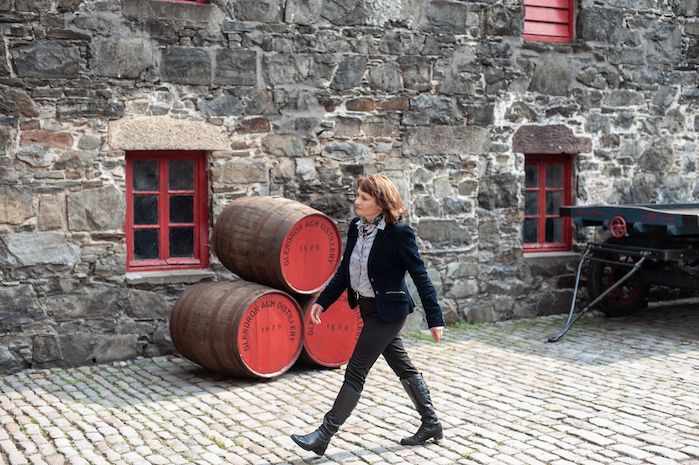Rachel Barrie has worked in whisky for 26 years but does not think of Scotch as old-fashioned. The master blender for Brown-Forman’s BenRiach, GlenDronach and other brands — and recently inducted into Whisky Magazine’s Hall of Fame — sees the spirit fitting perfectly into the Millennial mindset.
Yet Barrie also calls for a return to Scotch styles from the ‘60s and ‘70s. Why? Because that’s when whisky flavors were bolder, which once again lines up with the modern consumer palate. It’s all cyclical.
I recently spoke with Barrie about the present and future of Scotch.
Kyle Swartz: Some people criticize Scotch for lacking innovation. Do you agree?
Rachel Barrie: There’s been so much more innovation in the last three years. We’re seeing single malts get more clearly linked with the characters of their distilleries. We’re seeing more different cask types used than before. More virgin oaks, plus also different peated styles.
But it’s not just about one new cask type. It’s more than that. It’s about bringing malts to life. We’ve seen real growth recently coming from full-flavored malts in particular. We’re getting back to the traditional essence of Scotch.
The way the whisky world has been the last 10-to-20 years has been about blends and lighter malts. Now it’s becoming more about malts with a rich, strong, complex structure. Some distilleries have moved away from that traditional style, but we are true to it at GlenDronach and that’s why people appreciate the whisky. It’s like Scotch from the ‘60s and ‘70s, with richness instead of lightness or simplification.
KS: With the rise of premium Scotch blends, will we see a decrease in age statements?
RB: Age statements are here to stay. I think that for distilleries that have stuck with age statements, they believe these whiskies will be the winners at the end of the day.
At GlenDronach we have taken the long-term approach with age statements. They have the perfect balance of structure, complexity and finesse. We know our sweet spots with aging. Our 10- and 12-year-old Scotches will continue to grow and be where people buy more, because they’re approachable and represent quality at the right price.
KS: Scotch is a heavily taxed export in Scotland, leading to higher prices in America. How big of an issue is that?
RB: Every time I look at bourbon, the prices go up. Now you can get 18-year-old single malts at the same price as some of these bourbons. You can still get phenomenal quality from an age statement at a decent price, especially when you look at the broader whisky market.
KS: Stigmas exist for Scotch that it’s the dusty bottles that grandpa drank. How can the category counter that?
RB: I suppose that Millennials have become that community that everyone wants to know what they’re thinking and drinking. Though it’s always an interesting, exciting journey when you can engage with any consumer about learning more about whisky.
All that ‘baggage’ Scotch has — it’s just Scotch! What more is there to say about it?
But remember that when you have a malt distillery that you can visit, see the terroir and the heritage, you can really taste the essence of the place. It’s a whole different experience. That’s why I think that single malts are more the path into Scotch for Millennials than with blends, because of that journey of going to that place.
And Millennials are embracing the diversity of malts. Scotch is one of the most diverse spirits in the world. Millennials want to embrace diversity. Everything about single malts is absolutely in line with my impression of how open-minded and diverse-thinking people are becoming.
KS: We’re seeing more scotch cocktails with single malts. Thoughts?
RB: Gone are the days of people drinking just whisky and coke, or just any old blend of Scotch with any old mixer. Now because of how much the consumer is learning, and embracing diversity, they’re mixing with single malts. They know now that they can play with it on their own way now. The industry has evolved. Something has really made us all open up our minds.
Kyle Swartz is editor of Beverage Dynamics magazine. Reach him at kswartz@epgmediallc.com or on Twitter @kswartzz or Instagram @cheers_magazine. Read his recent piece 8 American Whiskey Trends in 2019.







[…] in U.S. and global markets, these two new expressions from Master Blender Rachel Barrie are meant to represent The GlenDronach’s tradition, since 1826, of marrying Highland spirit with […]
[…] history for inspiration in developing the new core range, the company says, which was crafted by Master Blender Rachel Barrie and her team. Inspired by the 1994 bottling of the Original Ten with its fruit-laden profile and […]
[…] sherry cask maturation, which uses the finest Spanish oak,” says The GlenDronach Master Blender Dr. Rachel Barrie. “This extra maturation in Port casks imparts a deep cherry wood color and enriches the layers of […]
[…] sherry cask maturation, which uses the finest Spanish oak,” says The GlenDronach Master Blender Dr. Rachel Barrie. “This extra maturation in Port casks imparts a deep cherry wood color and enriches the layers of […]
[…] Batch 18 collection, as a whole globally, features a variety of cask types and maturation periods. Master Blender Rachel Barrie selected 18 casks dating from 1990 to 2009 for the series. These include sweet and rich Pedro […]
[…] malting process keeps a traditional part of the whisky-making process alive with Benriach,” says Barrie. “Meanwhile Smoke Season is a special time of year in the distillery’s calendar, and these […]